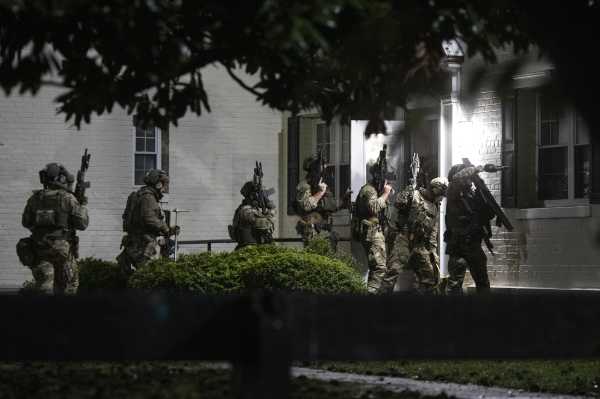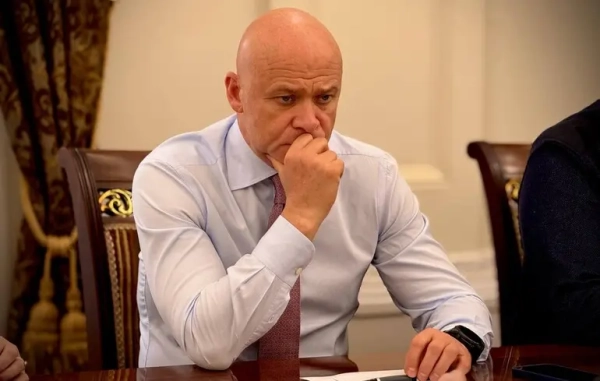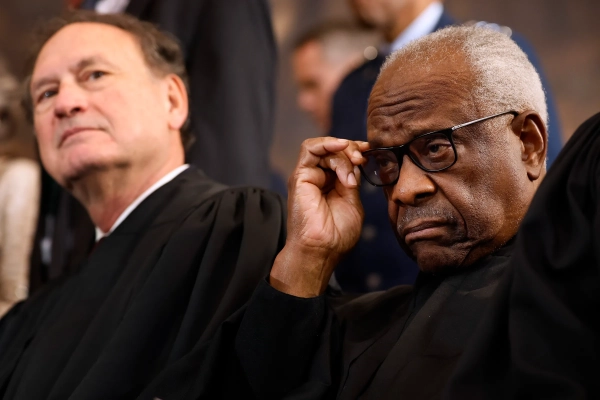 decide whether to stop him />
decide whether to stop him />
In July, a Trump appointee to a federal court in Texas effectively seized control of parts of Immigration and Customs Enforcement (ICE), the federal agency that enforces immigration laws within US borders. Although Judge Drew Tipton’s opinion in United States v. Texas contains a simply astonishing array of legal and factual errors, the Supreme Court has thus far tolerated Tipton’s overreach and permitted his order to remain in effect.
Nearly five months later, the Supreme Court will give the Texas case a full hearing on Tuesday. And there’s a good chance that even this Court, where Republican appointees control two-thirds of the seats, will reverse Tipton’s decision — his opinion is that bad.
The case involves a memo that Secretary of Homeland Security Alejandro Mayorkas issued in September 2021, instructing ICE agents to prioritize undocumented immigrants who “pose a threat to national security, public safety, and border security and thus threaten America’s well-being” when making arrests or otherwise enforcing immigration law.
A federal statute explicitly states that the homeland security secretary “shall be responsible” for “establishing national immigration enforcement policies and priorities,” and the department issued similar memos setting enforcement priorities in 2005, 2010, 2011, 2014, and 2017.
Nevertheless, the Republican attorneys general of Texas and Louisiana asked Tipton to invalidate Mayorkas’s memo. And Tipton defied the statute permitting Mayorkas to set enforcement priorities — and a whole host of other, well-established legal principles — and declared Mayorkas’s enforcement priorities invalid. This is not the first time that Tipton relied on highly dubious legal reasoning to sabotage the Biden administration’s immigration policies.
In July, shortly after Tipton handed down his decision, the Justice Department asked the Supreme Court to halt Tipton’s order while this case was still pending, but the Supreme Court voted 5-4 to deny that request — with conservative Justice Amy Coney Barrett crossing over to vote with the Court’s three liberal justices. That means that, even if the Court does ultimately reject Tipton’s reasoning, his erroneous order will have been in effect for months by the time the Supreme Court strikes it down.
And for that entire time, Mayorkas will have been prevented from exercising his statutory authority over ICE.
Tipton’s opinion is an embarrassment
As a threshold matter, it’s important to understand why Mayorkas must have authority to set enforcement priorities for ICE. As the Justice Department explained in a 2014 memo, “there are approximately 11.3 million undocumented aliens in the country,” but Congress has only appropriated enough resources to “remove fewer than 400,000 such aliens each year.”
So it is literally impossible for ICE to arrest or otherwise bring enforcement actions against every undocumented immigrant in the country. Priorities must be set.
The Supreme Court has long acknowledged that law enforcement, by its very nature, requires police and similar officials to make decisions about which arrests to make, which enforcement actions to bring, and how to allocate the limited number of officers employed by an agency. And it has warned courts not to interfere with these kinds of decisions, especially when law enforcement decides not to target someone for arrest or enforcement.
As the Court held in Heckler v. Chaney (1985), “an agency’s decision not to prosecute or enforce, whether through civil or criminal process, is a decision generally committed to an agency’s absolute discretion.” This principle, the Court added, “is attributable in no small part to the general unsuitability for judicial review of agency decisions to refuse enforcement.”
So if the leaders of a law enforcement agency decide that a particular class of people are not a high priority for enforcement, even if those individuals have violated federal law, Heckler says that judges like Drew Tipton should generally stay the heck away from that decision.
This general rule, that law enforcement agencies, not judges, should decide their own enforcement priorities, is known as “prosecutorial discretion,” and it is one of the fundaments of how police and prosecutors operate at all levels of the government.
Here’s a fairly banal example of how prosecutorial discretion works: Suppose that there are a rash of home break-ins in Washington, DC’s Columbia Heights neighborhood. Police precinct commanders, the city’s police chief, or even the city’s mayor may respond to this development by ordering DC cops to spend more time patrolling Columbia Heights — even though that means that crimes in other neighborhoods might go uninvestigated or unsolved.
Similarly, if you’ve ever been pulled over by a police officer for a minor traffic violation, then let off with a warning, you have benefited from prosecutorial discretion. It would be nonsensical for judges to monitor every decision made by every law enforcement officer and their commanders about when to make an arrest or bring an enforcement action. And the Supreme Court has repeatedly warned judges against doing so.
This general rule is especially strong in the immigration context. The Supreme Court has said that “a principal feature of the removal system is the broad discretion exercised by immigration officials.” Even after the federal government decides to bring a removal proceeding against a particular immigrant, the Court said in Reno v. American-Arab Anti-Discrimination Committee (1999), that the government “has discretion to abandon the endeavor.” And it may do so for any number of reasons, including “humanitarian reasons or simply for its own convenience.”
Indeed, the Supreme Court has held that law enforcement’s discretion to decide not to target certain individuals is so “deep-rooted” that it can overcome a legislative command stating that law enforcement officers “shall arrest” a particular class of persons. This principle dates at least as far back as the Court’s decision in Railroad Company v. Hecht (1877), which held that “as against the government, the word ‘shall,’ when used in statutes, is to be construed as ‘may,’ unless a contrary intention is manifest.”
Which brings us to Tipton’s primary argument in ruling with the plaintiffs against the ICE enforcement guidelines. He relies on two federal statutes, one of which says that the government “shall take into custody” immigrants who’ve committed certain offenses, and another saying that the government “shall remove” immigrants within 90 days after an immigration proceeding orders them removed.
To someone unfamiliar with the Court’s decisions in Heckler, Reno, Railroad Company, and numerous other precedents counseling judges not to interfere with non-enforcement decisions, Tipton’s statutory argument might have an air of plausibility. But, of course, judges are expected to actually familiarize themselves with controlling Supreme Court precedents before they hand down a decision — including the ones saying that the doctrine of prosecutorial discretion overcomes statutes with seemingly mandatory language.
Also, even presuming that the Supreme Court’s precedents can be ignored and that Tipton is bound only by the text of the two statutes he relies upon, his decision is still wrong. The first statute provides that “no court may set aside any action or decision … regarding the detention or release of any alien or the grant, revocation, or denial of bond or parole.” And the second provides that “nothing in this section shall be construed to create any substantive or procedural right or benefit that is legally enforceable by any party against the United States or its agencies or officers or any other person.”
Both Congress and the Supreme Court, in other words, told Tipton not to interfere with Secretary Mayorkas’s decisions regarding law enforcement priorities. But Tipton didn’t care.
There also are numerous other problems with Tipton’s opinion, some of which are so glaring that they suggest he’s operating in bad faith.
Tipton claims, for example, that Mayorkas was required to complete a time-consuming process known as “notice and comment” before he could set new priorities for ICE. But federal law exempts “general statements of policy” from notice and comment. And, in Lincoln v. Vigil (1993), the Supreme Court held that these “general statements of policy” include “‘statements issued by an agency to advise the public prospectively of the manner in which the agency proposes to exercise a discretionary power’“ — such as the Department of Homeland Security’s discretionary authority over enforcement decisions.
Similarly, Tipton faulted Mayorkas’s memo because it supposedly failed to consider “the costs its decision imposes on the States.” But a 21-page document accompanying Mayorkas’s memo includes a subsection titled “Impact on States.” That subsection concludes that “none of the asserted negative effects on States — either in the form of costs or the form of undermining reliance interests” — undercut the benefits of Mayorkas’s enforcement priorities.
I could go on — and if you care to take a deeper dive into the many faults with Tipton’s reasoning, I’ll point out that the Justice Department’s brief in the Texas case also makes several strong arguments that Texas and Louisiana, the plaintiffs in this case, aren’t even allowed to file this lawsuit in the first place.
But, honestly, listing all of the many errors in Tipton’s omnishambles of an opinion would require me to go on at such length, I fear my readers would lose interest. So I will do all of you the service of stopping here.
It’s not a coincidence that this case was assigned to Drew Tipton
According to an amicus brief filed by University of Texas law professor Stephen Vladeck, the state of Texas has filed 20 lawsuits in Texas federal courts against the Biden administration. All but one of those cases are overseen by judges appointed by a Republican president.
As Vladeck explains, this did not happen by coincidence. Rather, “Texas has intentionally filed its cases in a manner designed to all-but foreclose having to appear before judges appointed during Democratic presidencies.”
The federal court system includes 94 different district courts, trial courts that each preside over a geographic region. Texas, for example, is divided into four districts — the Northern, Eastern, Southern, and Western Districts of Texas. These four district courts, meanwhile, are chopped up into “divisions,” often named after the city or town where a federal courthouse is located. Tipton, for example, sits in the Victoria Division of the Southern District of Texas.
Under a case assignment order handed down by the Southern District of Texas, virtually all civil cases filed in the Victoria Division are automatically assigned to Tipton. Thus, as Vladeck writes, “by filing this case in Victoria, Texas was able to select not just the location for its lawsuit, but the specific federal judge who would decide this case: a judge Texas likely believed would” rule against the Biden administration — “and who in fact did so, even as another court has rejected similar challenges.”
The Supreme Court has thus far been very indulgent of this behavior, at least when it benefits Republicans. In 2021, for example, Texas chose Trump-appointed Judge Matthew Kacsmaryk to hear a lawsuit seeking to reinstate a Trump-era border policy known as “Remain in Mexico.” Kacsmaryk predictably did Texas’s bidding, and ordered the Biden administration to reinstate Texas Republicans’ preferred policy.
Although the Supreme Court eventually reversed Kacsmaryk’s decision, which was as inconsistent with existing law as is Tipton’s decision in Texas, the Court sat on the case for nearly an entire year — effectively letting Kacsmaryk set the nation’s border policy for this entire waiting period. Now the Court appears likely to repeat this pattern in Tipton’s case.
In case there is any doubt, this is not how the Supreme Court behaved when Trump was in office. During the Trump administration, the Court’s Republican-appointed majority was so quick to intervene when a lower court judge blocked one of Trump’s policies that Justice Sonia Sotomayor complained that her colleagues were “putting a thumb on the scale in favor of” the Trump administration.
Even when the law offers no support for the GOP’s preferred policies, in other words, the Court permits Republicans to manipulate judicial procedures in order to get the results they want. The Texas attorney general’s office can handpick judges who they know will strike down Biden administration policies, and once those policies are declared invalid, the Supreme Court will play along with these partisan judges’ decisions for at least a year or so.
Sourse: vox.com






